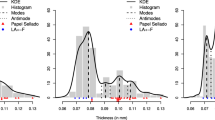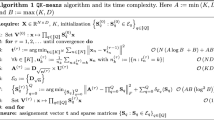Abstract
Clustering by mode seeking is most popular using the mean shift algorithm. A less well known alternative with different properties on the computational complexity is kNN mode seeking, based on the nearest neighbor rule instead of the Parzen kernel density estimator. It is faster and allows for much higher dimensionalities. We compare the performances of both procedures using a number of labeled datasets. The retrieved clusters are compared with the given class labels. In addition, the properties of the procedures are investigated for prototype selection.
It is shown that kNN mode seeking is well performing and is feasible for large scale problems with hundreds of dimensions and up to a hundred thousand data points. The mean shift algorithm may perform better than kNN mode seeking for smaller dataset sizes.
Chapter PDF
Similar content being viewed by others
Keywords
These keywords were added by machine and not by the authors. This process is experimental and the keywords may be updated as the learning algorithm improves.
References
Bradley, A.P.: The use of the area under the ROC curve in the evaluation of machine learning algorithms. Pattern Recognition 30(7), 1145–1159 (1997)
Cheng, Y.: Mean shift, mode seeking, and clustering. IEEE Trans. Pattern Anal. Mach. Intell. 17(8), 790–799 (1995)
Comaniciu, D., Meer, P.: Mean shift: A robust approach toward feature space analysis. IEEE Trans. Pattern Anal. Mach. Intell. 24(5), 603–619 (2002)
Duin, R., Juszczak, P., de Ridder, D., Paclík, P., Pękalska, E., Tax, D., Verzakov, S.: PRTools 4.1, a Matlab toolbox for pattern recognition, http://prtools.org
Finkston, B.: Mean shift clustering
Frank, A., Asuncion, A.: UCI machine learning repository (2010), http://archive.ics.uci.edu/ml
Fukunaga, K., Hostetler, L.D.: The estimation of the gradient of a density function, with applications in pattern recognition. IEEE Trans. Information Theory 21(1), 32–40 (1975)
Kittler, J.V.: A locally sensitive method for cluster analysis. Pattern Recognition 8(1), 23–33 (1976)
Koontz, W.L.G., Narendra, P.M., Fukunaga, K.: A graph-theoretic approach to nonparametric cluster analysis. IEEE Trans. Computer 25, 936–944 (1976)
Shaffer, E., Dubes, R.C., Jain, A.K.: Single-link characteristics of a mode-seeking clustering algorithm. Pattern Recognition 11(1), 65–70 (1979)
Author information
Authors and Affiliations
Editor information
Editors and Affiliations
Rights and permissions
Copyright information
© 2012 Springer-Verlag Berlin Heidelberg
About this paper
Cite this paper
Duin, R.P.W., Fred, A.L.N., Loog, M., Pękalska, E. (2012). Mode Seeking Clustering by KNN and Mean Shift Evaluated. In: Gimel’farb, G., et al. Structural, Syntactic, and Statistical Pattern Recognition. SSPR /SPR 2012. Lecture Notes in Computer Science, vol 7626. Springer, Berlin, Heidelberg. https://doi.org/10.1007/978-3-642-34166-3_6
Download citation
DOI: https://doi.org/10.1007/978-3-642-34166-3_6
Publisher Name: Springer, Berlin, Heidelberg
Print ISBN: 978-3-642-34165-6
Online ISBN: 978-3-642-34166-3
eBook Packages: Computer ScienceComputer Science (R0)





